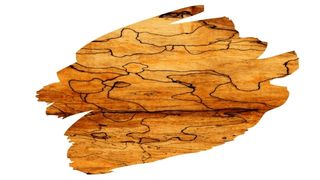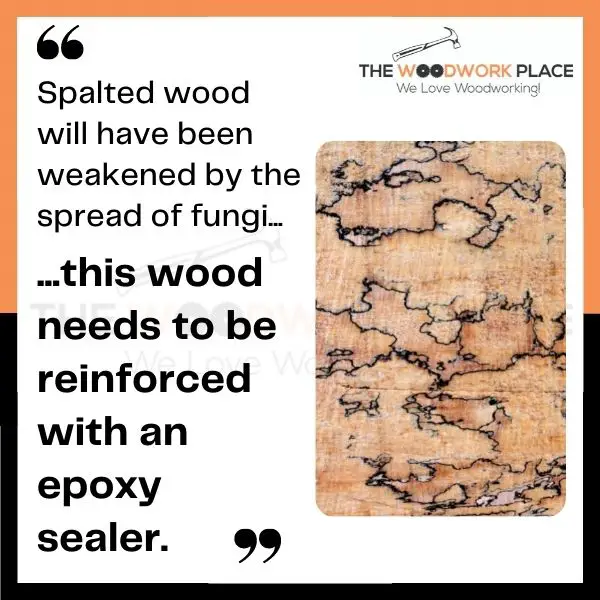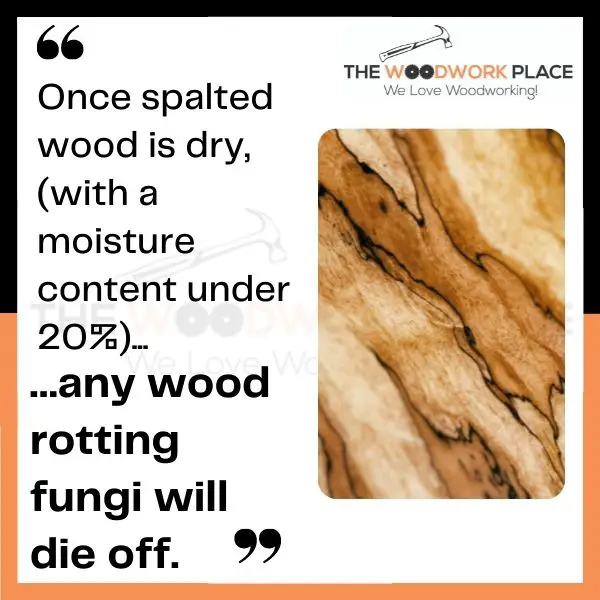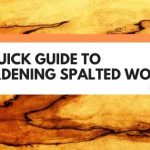Spalted wood is one of the most attractive types of timber you can work with. And getting your hands on this difficult-to-find lumber will cost you a pretty penny.
Yet every now and then, you might stumble across a piece of spalted wood hidden unnoticed in a stack of firewood. Or you may even happen across some spalted wood laying about outside.
In which case, you can use this wood to make incredibly artistic crafts. However, underneath spalted woods pretty surface, the density and strength of this lumber has been compromised.
That’s because the fungi responsible for spalting, can also compromise the integrity of wood itself.
Spalted wood is basically wood that’s begun to rot away. Based on that alone, spalted wood should have no place in your kitchen… right?
Well, in this post, you will learn what’s really behind spalting…and why it weakens the integrity of wood. You will also discover whether spalting is dangerous to your health…and how to prevent it from further spreading throughout timber.
And we explain why reinforcing spalted wood is so important…and what this means for your spalted wood cutting board project.

This post may contain affiliate links to products that we receive a commission for (at no additional cost to you). Learn more here.
What Causes Spalting In The First Place?
Spalted wood coloration may be easy on the eyes, but there is a lot going on underneath the surface. Those spalting patterns are caused by white rot, which is a type of fungi that thrives in damp wood.
This white rot fungi eats away at the strength and density of any plant life it happens upon. And over time, white rot will completely breakdown that piece of timber.
Once that happens, then before long, that piece of lumber will become rot-riddled punky wood.
Related Post: Is Olive Wood Good Enough For A Cutting Board?
Is Spalted Wood Very Weak And Soft?
Spalted wood is made weak by rot, because rot actively works to break down the fiber tissues of trees.
This makes spalted wood less stable, and liable to crumble away in your hand if you held it.

Do You Really Need To Treat Spalted Wood Before Using It?
If you don’t stop the spread of rot, spalted wood won’t be worth much at all. So, you need to treat spalted wood before you begin working with it.
White rot, (which is the fungi creating those spalting streaks), loves to live in damp soft lumber. And this fungi will die off if you dry out that piece wood.
So, if you can reduce spalted woods moisture content to under 20%, that wood will be too dry for fungi to stay alive.
Now, if you purchased your spalted wood already kiln dried, then this shouldn’t be an issue. Kiln drying will have already reduced spalted woods moisture content for you.
Otherwise, you’ll need to dry that piece of spalted lumber out yourself.
You can learn more about stabilizing spalted wood in our post here: A Quick Guide To Hardening Spalted Wood | TheWoodworkPlace.com
What Do You Mean By The Term ‘Moisture Content’? Moisture content measures the amount of moisture in any given piece of wood. Freshly cut lumber has a moisture content of 100 percent. However, wood that has been kiln dried and pressure treated, (KDAT-stamped wood), has a moisture content of less than 19 percent.
Is Spalted Wood Toxic (Or Otherwise Dangerous)?
White rot can release airborne spores. These spores, while not toxic, can however cause allergic reactions and breathing problems if inhaled.
However, once you dry out spalted wood and kill off the fungi, spores no longer get released into the air. And if you properly treat and seal spalted wood, this fungi no longer poses a danger to human health.
Related Post: Rotting Wood Around Your Sink? 3 Ways To Protect That Wooden Worktop | TheWoodworkPlace.com
Well, Is Spalted Wood Food Safe?
If you properly dry, stabilize and seal spalted wood, then the surface of this lumber is food safe.
Now, it’s important to state that no matter what spalted wood is used for, it must be stabilized before use.
Drying out lumber isn’t unusual. Referred to as seasoning wood, this is standard practice.
And sealing wood, (to protect it from rot and decay), is common practice too.
However, when it comes to finishing spalted wood, you also need to add an extra finishing step by stabilizing it.
We stabilize spalted wood by treating it with a wood strengthening resin. You do this so that you reinforce and harden up the sections of spalted wood that have decayed away.
But, if you stabilize spalted wood, you inadvertently make it unsuitable for use as a cutting board.

How Do You Treat Spalted Wood?
Coating spalted wood with a penetrating epoxy sealer is the best way to fill in those missing gaps. It’s a quick and easy way to repair all types of punky wood, and will work just as well on a piece of spalted wood too.
But, these resins are not hard enough to shrug off the sharp bite of a chopping kitchen utensil.
Epoxy sealer can be easily sanded…which means it can be easily scratched and sliced as well. Which means little bits of epoxy could end up in your food!
Also, by sealing over wood, you’ll prevent penetrating finishes (such as cutting board mineral oil) from sinking into chopping blocks.
Related Post: Walnut Oil Vs Mineral Oil: Which One’s Better For Your Cutting Board? | TheWoodworkPlace.com
So, Can You Use Spalted Wood For A Cutting Board?
If you’re making a cutting board for artistic decoration, then sure, go right ahead.
However, if you plan on using that board for food prep, then spalted wood is not a practical choice for your cutting board.
Spalted wood needs to be strengthened. And the epoxy or hardener used to strengthen spalted wood will make the surface of this timber unsafe for food prep.
But without hardener, spalted wood won’t be tough enough to handle the daily chop of your kitchen utensils.
To Sum Up, Here Are The 3 Key Takeaways From This Post…
- Once spalted wood is dry, (with a moisture content under 20%), any wood rotting fungi will die off.
- Spalted wood will have been weakened by the spread of fungi. So, this wood needs to be reinforced with an epoxy sealer.
- Your sharp kitchen utensils will scratch and slice through epoxy sealer. This makes epoxy hardened spalted wood unsuitable as a food prep surface.
Reference:
Producing Spalted Wood | Forest Products Laboratory
C. del Cerro, E. Erickson et al. Intracellular pathways for lignin catabolism in white-rot fungi. PNAS. 118, e2017381118 (2021). [DOI: 10.1073/pnas.2017381118]

